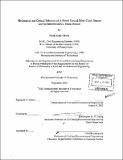| dc.contributor.advisor | Christopher K.Y. Leung. | en_US |
| dc.contributor.author | Olson, Noah Gale, 1969- | en_US |
| dc.contributor.other | Massachusetts Institute of Technology. Dept. of Civil and Environmental Engineering. | en_US |
| dc.date.accessioned | 2005-10-14T19:29:59Z | |
| dc.date.available | 2005-10-14T19:29:59Z | |
| dc.date.copyright | 2002 | en_US |
| dc.date.issued | 2002 | en_US |
| dc.identifier.uri | http://hdl.handle.net/1721.1/29259 | |
| dc.description | Thesis (Ph. D .)--Massachusetts Institute of Technology, Dept. of Civil and Environmental Engineering, 2002. | en_US |
| dc.description | Includes bibliographical references. | en_US |
| dc.description.abstract | The proper interpretation of measurements from an optical fiber sensor requires a full understanding of its mechanical response to external action and the corresponding change in optical output. To quantify the mechanical behavior it is necessary to know the mechanical properties of the fiber coatings. A new method for measuring the coating stiffness directly on the fiber uses nano-indentation. Special sample preparation and testing procedures were developed for the measurement of very low modulus materials using the Nano Indenter II. Results are obtained for two different acrylate coated optical fibers, namely Corning SMF28 and 3M FS-SN-4228. These results are used in understanding the behavior of the novel crack sensor and of an interferometric strain sensor. A distributed crack sensor that does not require prior knowledge of crack location and employs a small number of fibers to monitor a large number of cracks is developed. The basic design of the sensor is a polymer sheet containing an inclined fiber that is coupled to a structure. The sensor principle is that cracking in the structural member leads to cracking in the polymer sheet which induces fiber bending leading to signal loss. Monitoring the backscattered signal provides crack opening size and location. A theoretical model for optical fiber loss prediction is developed based on a combination of mechanical and optical analyses. | en_US |
| dc.description.abstract | (cont.) Model prediction is found to be in relatively close agreement with experimental results. Model simulation can hence be carried out to provide guidelines for designing crack sensors for various applications. The behavior of both coated and uncoated fibers for strain measurement applications is also examined. A theoretical assessment using a three-dimensional finite element model for both coated and uncoated optical fibers is presented. Results show that the coating stiffness can significantly affect the strain transfer from the member under load to the optical fiber. The three-dimensional finite element model can provide guidelines for the optimized design of strain sensors. A straightforward analytical solution shows good equivalence with the theoretical solution under certain conditions. Experiments using an interferometer were conducted to verify the results of the theoretical study and show good correspondence. | en_US |
| dc.description.statementofresponsibility | by Noah Gale Olson. | en_US |
| dc.format.extent | 220 leaves | en_US |
| dc.format.extent | 9058832 bytes | |
| dc.format.extent | 9058641 bytes | |
| dc.format.mimetype | application/pdf | |
| dc.format.mimetype | application/pdf | |
| dc.language.iso | eng | en_US |
| dc.publisher | Massachusetts Institute of Technology | en_US |
| dc.rights | M.I.T. theses are protected by copyright. They may be viewed from this source for any purpose, but reproduction or distribution in any format is prohibited without written permission. See provided URL for inquiries about permission. | en_US |
| dc.rights.uri | http://dspace.mit.edu/handle/1721.1/7582 | |
| dc.subject | Civil and Environmental Engineering. | en_US |
| dc.title | Mechanical and optical behavior of a novel optical fiber crack sensor and an interferometric strain sensor | en_US |
| dc.type | Thesis | en_US |
| dc.description.degree | Ph.D . | en_US |
| dc.contributor.department | Massachusetts Institute of Technology. Department of Civil and Environmental Engineering | |
| dc.identifier.oclc | 51883553 | en_US |
